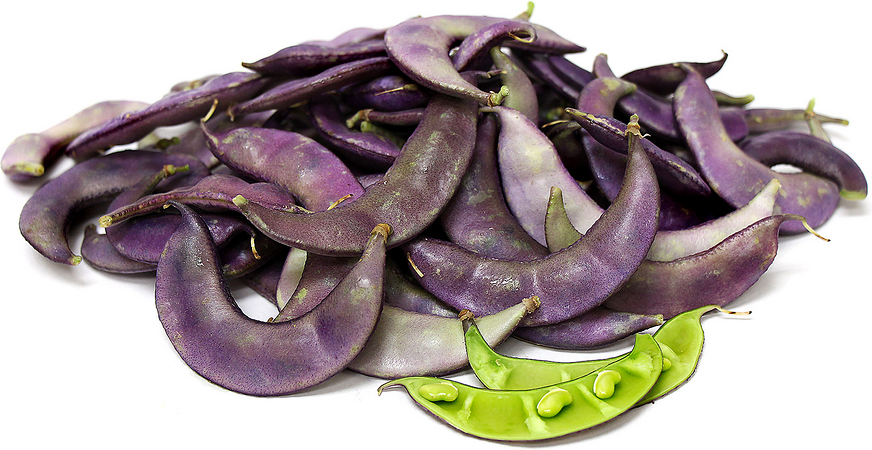


Ruby Moon Beans
Estimated Inventory, lb : 0
Description/Taste
Ruby Moon beans grow on long green trailing vines. The pods of the beans typically reach lengths of 15 to 20 centimeters, while the beans encased within the pods measure about 1 to 1.5 centimeters. These beans are medium-sized and similar in form and dimension to a green pea. The weight and density of Ruby Moon beans are proportionate to their size; however, these attributes vary depending on their state. Fresh beans are denser and heavier compared to their dried counterparts. Each oval-shaped pod has a bumpy texture due to the beans it carries inside. The exterior has a bright purple hue and glossy texture, a characteristic that enhances their aesthetic appeal when added to culinary dishes. Both the pod's interior and the beans within are light green. The beans are starchy and dense with a malleable texture, lying flat against the seed like Sugar Snap peas. Ruby Moon beans emit a subtle, earthy aroma that intensifies into a more pronounced nutty scent when cooked. Consistent with this earthy and nutty profile, their flavor adds a savory depth to dishes akin to many other legumes.
Seasons/Availability
Ruby Moon beans appear on their vines in mid to late summer.
Current Facts
Ruby Moon beans, botanically classified as Dolichos lablab, are an heiroom species belonging to the Fabaceae family. Ruby Moon beans are also called Lab Lab, an aboriginal name, or Purple Hyacinth beans. Unlike true beans, they are more closely related to the pea. The pods grow on vines with small purple and white flowers. Originating from Egypt, Ruby Moon beans are predominantly used for ornamental purposes and are celebrated for their vibrant hue. They are also used on a small scale in medicinal and culinary preparations. Throughout history, Ruby Moon beans have spread to home gardens worldwide for their vibrant, ornamental appeal, and the species was notably grown at Monticello, Thomas Jefferson’s 5,000-acre Virginia estate built in 1772.
Nutritional Value
Ruby Moon beans are a source of plant-based protein, beneficial for muscle repair. They contain dietary fiber, which supports digestion, heart health, and blood sugar control. Ruby moon beans are also rich in B vitamins, iron, potassium, magnesium, and zinc, which are necessary for energy metabolism and a healthy nervous system. Since they're low in fat and calories, Ruby Moon beans can help with weight management. The complex carbohydrates in Ruby Moon beans deliver a gradual and sustained energy release, helping to maintain steady energy levels over time and prevent the rapid blood sugar spikes and crashes associated with simple sugars. These beans have been used in traditional Chinese herbal remedies for fever reduction, appetite stimulation, and spleen enhancement.
Applications
Immature Ruby Moon beans are edible raw; however, their pods contain cyanogenic glucosides, natural antimicrobial agents produced by the plant. These compounds serve as a defense against herbivores by imparting a bitter taste to the beans. Because of this, the ripe beans should not be consumed raw but should instead be cooked or dried. When cooking the beans, you must boil and drain them several times to rid the bean toxins. It is also worth noting their vibrant purple hues will reduce to a modest green when cooked. Ruby Moon beans are a popular ingredient in Asian, Thai, and Indian cuisines, where they are used in curries. The immature beans and flowers are also eaten as a vegetable in Africa. The flowers of the Ruby Moon bean plant can be eaten raw, steamed, or used as a garnish on desserts and salads. Ruby Moon beans pair well with rice, quinoa, spinach, carrots, corn, zucchini, meat, garlic, onions, tomatoes, nuts, and mild cheeses like goat or feta. You can enhance their flavor with cumin, turmeric, paprika, coriander, parsley, thyme, and coconut milk. To store Ruby Moon beans, first extract the seeds from the pods, then store them in a cool, dry place in an airtight container that lasts up to a year.
Ethnic/Cultural Info
Ruby Moon beans have a history dating back several centuries in Asia and Africa. In these regions, the species was a staple food source, used in soups and stews for its protein. Ruby Moon beans are also known for boosting soil fertility, thanks to the bacteria that live in their roots. This bacteria can take nitrogen from the air and convert it into a form of plant food. This process enriches the soil with essential nutrients, facilitating the growth of a wide variety of plants and reducing the reliance on chemical fertilizers.
Geography/History
Originally from Egypt, Ruby Moon beans are cultivated as a pulse crop, similar to soybeans. This means they are grown for both animal and human consumption. Ruby Moon beans grow in tropical climates with full sun exposure and well-drained soil. They grow in Southeast Asian and Eastern African countries, including Egypt, Madagascar, India, Thailand, Nigeria, Kenya, Tanzania, and Sri Lanka. In addition to these regions, they can also thrive in warm areas of Australia and the southern United States. Ruby Moon beans are commercially grown in these countries and are equally popular in home gardens, where they are often trellised for their unique and colorful aesthetic. You can find Ruby Moon beans in their seed form at many nurseries and are usually found at markets in Asia and Africa.




